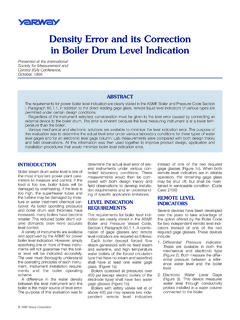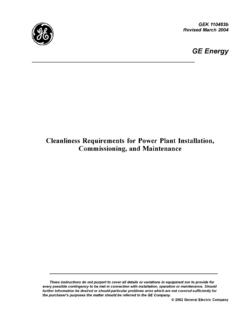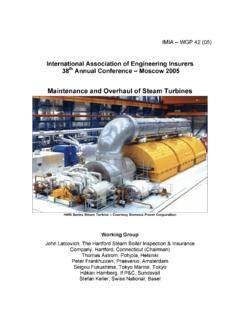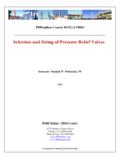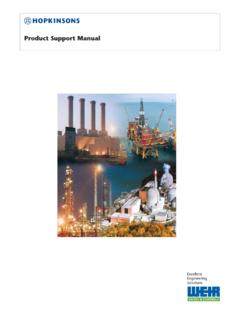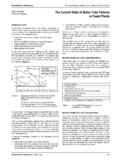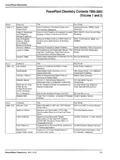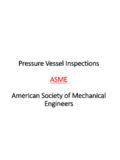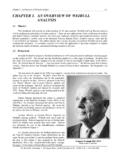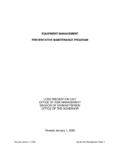Transcription of 7.0 Chemical Treatment - Steam Turbine, Steam …
1 Association of Water Technologies Technical ManualBoiler Systems Chapter 3 Chemical OVERVIEW This section deals with specific Chemical treatments. Type, purpose, and application are all discussed. The treatments are divided along the lines of preboiler and condensate systems, and the boiler itself. The preboiler system is usually treated with pH adjustment chemicals, amines, and oxygen control chemicals, called scavengers. The condensate system is treated with pH adjustment and corrosion control chemicals, volatile amines and filming amines.
2 The boiler is treated with chemicals to control deposition of salts and corrosion products, buffering of pH, and main objective in every case is to permit the safe and efficient operation of the boiler and Steam handling system. Corrosion control aids in boiler cleanliness and prevention of equipment failures. Deposit control aids in the maintenance of good heat transfer, which translates into better efficiency and prevention of tube failures. In the condensate system, corrosion and deposit control are essential for recovery of condensate for re-use.
3 In discussing Chemical Treatment in boiler systems, the following terminology will be used:x Pretreatment or external Treatment : Chemical and physical Treatment of makeup water to prepare a consistent, satisfactory quality boiler feedwater. x Internal Treatment : Chemical Treatment of the boiler water to control mineral scaling, corrosion and general deposition in the boiler drums and boiler tubes. x Condensate Treatment : Chemical Treatment of Steam condensate, applied either in the Steam lines or in the boiler , to control carbonic acid and dissolved oxygen corrosion in the condensate lines.
4 As a general rule, the higher the boiler pressure, the higher the quality of feedwater required. Therefore, the higher the pressure, the more Chemical Treatment is concentrated outside the boiler in water preparation (chapter 2), and the less internal boiler water Treatment and condensate Treatment is required. Boilers are often classified by operating (throttle) pressure. These groupings are arbitrary, and there is much overlapping between groups, but for purposes of discussing Chemical Treatment the following groupings are convenient: xLow pressure steaming boilers, operating below about 300 psig, that use untreated, or at best zeolite softened feedwater to make Steam primarily for HVAC and humidification use.
5 Feedwater may or may not be mechanically deaerated. These boilers require substantial internal Treatment to maintain clean surfaces and prevent corrosion. Systems are simple, and precise control of Chemical dosages and boiler operations is generally not of Water Technologies Technical ManualBoiler Systems Chapter 3 xMedium pressure boilers, between about 300 and 900 psig, are the workhorses of industry. These boilers are designed in many different ways, either packaged or field-erected (section ) They provide Steam for heating, power generation, transportation and process uses in a wide variety of commercial, institutional and industrial facilities.
6 Feedwater is at least softened, and is normally demineralized and mechanically deaerated. Internal Chemical Treatment is required for alkalinity control to prevent boiler and condensate corrosion, and to prevent residual solids deposition. Dosages are lower than in low pressure boilers, but since many of these boilers are quite large, usage can be substantial. Chemical reactions are complex and careful control is required. Many of these boilers are controlled by manual testing, but automatic control is preferred, especially in higher pressure systems.
7 XHigh pressure boilers, between about 900 and 1200 psig, are used primarily for electric power generation, in large industrial plants and power stations. Feedwater is always demineralized and mechanically deaerated. Chemical dosages are low, primarily for alkalinity and corrosion control. Dosages are critical and control is almost always automated. xVery high pressure boilers, from above 1200 psig to supercritical pressures (section ) are found in large power generation stations. They require the highest possible purity feedwater but only very small amounts of Chemical Treatment .
8 Although not part of the above classification, hot water heating boilers are also an important segment of boiler water Treatment . These units are similar to closed cooling systems. Chemical Treatment of hot water heating boilers is discussed in this section and also in chapter 4 (cooling water). This chapter is organized by Chemical Treatment (oxygen scavengers, internal treatments, condensate Treatment , etc.). Then the treatments are classified by application to boilers in the pressure groupings above. OXYGEN CONTROL Dissolved oxygen can lead to severe corrosion in the economizer section and in the boiler .
9 In the feedwater system, it will contribute to metals transport into the boiler , where deposition can lead to under-deposit corrosion and long term overheating. Dissolved oxygen enters the system via makeup water, which is often air saturated, or leaks into condensers or through pump seals. The most common effect of dissolved oxygen is to increase the corrosion of the feedwater heaters. Copper and iron oxides are formed which break loose and travel to the boiler . These metal oxides deposit on the hottest part of the boiler tubes and create insulating deposits.
10 From the heat transfer discussion in section , such insulating deposits increase the temperature gradient needed to provide a constant heat flux. The temperature rises on the tube wall, and overheating may result. Over a long time, such overheating can lead to metal fatigue and failure. Copper deposits can also lead to galvanic corrosion of steel. 3-59 Association of Water Technologies Technical ManualBoiler Systems Chapter 3 Oxygen problems are especially severe where ammonia is present in significant quantities. In the presence of oxygen, ammonia is very corrosive to copper.
